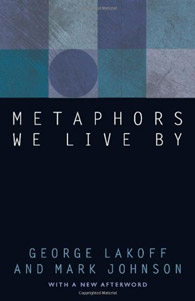The afterword, written more than twenty years later, primarily captures the success of their ideas. The evidence is given through multiple projects and publications too numerous to list here. Lakoff and Johnson recommend their book »The Philosophy in the Flesh« (1999) to philosophers interested in their experience-based ideas. The authors also make some minor corrections and clarifications to a few of the ideas, for example: argument is struggle not war. Finally it gives a short summary of the key ideas on metaphor and metaphorical concepts which have been confirmed and developed by empirical research. (p. 272–3)
»Metaphors We Live By« is a very complex book, and it needs to be read carefully to extract its maximum value. If the book has a weakness, it is in its organisation. Themes are distributed over various chapters, and the chapter titles do not always adequately represent the contents. Main ideas are sometimes placed in the middle of longer chapters or repeated in odd places, making them hard to follow. A different organisation would have aided understanding. The multiple intentions of the book also make it more difficult to decide what the key points of the work are, and indeed whether the final goal is linguistic, cognitive or philosophical in nature.
Why read this book? It gives the reader clues as to how human thought forms concepts based on experience. It underscores why some concepts and expressions of these are more natural to us than others. It is valuable to anyone interested in how people think.
Why should designers read this book? From a designer’s perspective these ideas are particularly valuable in developing effective visual concepts for abstract ideas. For instance, the ideas that concepts are made up of characteristic features that can be identified, or that people use archetypical (or prototypical) representatives to define a category, or that more abstract concepts are partially understood metaphorically help the designer design visual messages that the viewer understand naturally. We can easily take Lakoff and Johnson’s ideas further and see metaphor as a range of expressions across media and fundamentally linked to how we understand abstract ideas or new experiences. For example, in developing a visual signature (logo) for an organization the designer needs to very clearly identify the defining features of the organization and what they represent. Metaphor as the basis for visual (or other kinds of) expression is essential to finding an adequate signature that the uninformed observer easily (or naturally) understands. The ideas of natural kinds of experience are very important for the design of intuitive computer interfaces. Another interesting idea for designers is found in chapter 21. The authors illustrate that new metaphors or metaphorical concepts are not just descriptive, but can also be imaginative, insightful and creative. These new metaphors deepen our understanding of abstract concepts. For example, visual and other kinds of metaphors extend our understanding. Graphic signs come to represent regimes (swastika), or sports gear (Nike swoosh), and movies can extend our understanding of love, relationships, growing up, even plane crashes. Although written in 1980, the book is as relevant now as it was then. A recent article in »Design Issues«[3] demonstrates not only a current interest in the understanding of time metaphors, but also possible applications. Unraveling this book is work, but worth the effort because it provides a better understanding of how people make sense of their world.

